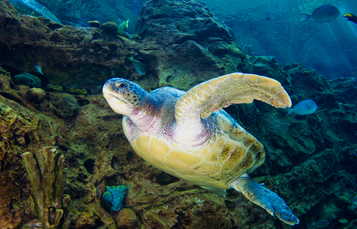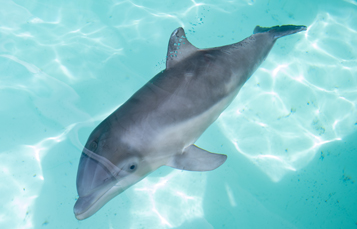How One Species is Helping Endangered & Threatened Animals up to Two Million Times Their Size at SeaWorld
May 20, 2019As a horticulturist, Mark Russell didn’t like bees. In fact, he wanted nothing to do with them and cringed at the thought of being stung. But when his boss popped his head over the edge of his cubicle one day during his tenure at an educational farm in Ohio, Russell found himself suddenly thrust into the role of farm beekeeper.
“My boss basically told me to start studying the beekeeping books at our Horticulture center and start taking care of them,” Russell says. “Several books and a couple times working with the bees later, I became absolutely fascinated.”
Today, Russell is the Senior Leader of General Services for the Orlando-based family of SeaWorld Parks, overseeing everything from plant engineering to facility maintenance, including horticulture. But part of his job is managing SeaWorld Orlando’s Honey Bee Conservation Program, which was created in part to provide a haven for bee colonies that have swarmed, a natural part of honeybee reproduction.
SeaWorld’s Honey Bee Conservation Program began in 2014 when the Horticulture Team installed swarm-attracting buckets around the SeaWorld Orlando’s park perimeter. The team quickly learned that there was a sweet payoff to their efforts: the bees produce raw honey, which the park’s veterinary team now uses to help heal rescued animals, many of which are threatened or endangered.
The bee hives in Orlando are cared for behind the scenes at the park, producing upwards of 300 to 400 pounds of honey a year: more than enough of the sticky stuff for all three Orlando parks to use in their care and treatment of animals.
Honey has long been used for wound care on human and animals: it has antimicrobial properties, high levels of antioxidants and, when applied to the surface of a wound, releases hydrogen peroxide to kill bacteria.
The honey’s most common users are rescued animals brought in after sustaining injuries from boat strikes, entanglements, predator bites, car strikes and other injuries. SeaWorld uses the granulated honey on manatees, sea turtles, birds, gopher tortoises and sometimes rescued cetaceans, including “Sharkie” – a dolphin that was rescued, rehabilitated and returned to the ocean after sustaining significant shark bite wounds last year.
And the people that make this all possible? A team of volunteers from the park’s Horticulture, Culinary and Zoology staff.
“I don’t like calling them the Bee Team, because that makes them sounds like they’re not the A Team,” Russell says. “They just love animals, even though honey bees aren’t what most people want to get close to. But this team works very calmly with the bees.”
Since the program began, SeaWorld Orlando has saved more than one million honey bees. And the bees? They’ve helped heal a portion of the 34,000 animals the SeaWorld Animal Rescue Teams has rescued in the last 50 years.
Many of us may still have an initial fear of bees, but as the Bee Team already knows, hives can be worked very safely, and all bees are completely fascinating!
++
How You Can Help Protect Bees on World Bee Day (and Every Day)
Sadly, bee colonies have been impacted around the world due to factors like pollution, habitat loss and disease-carrying mites. As you plan your garden or freshen up your landscaping this spring, consider selecting diverse, nectar-rich plants that will help sustain local bee colonies, and reduce the use of pesticides whenever possible. Contact your local garden center or beekeeping association to find out what plants are best for bees in your location!



.ashx?version=1_202404022246&h=468&w=766&la=en&hash=8DE65BD619660B17C9F60D61E7DCD1D3C7809F39)